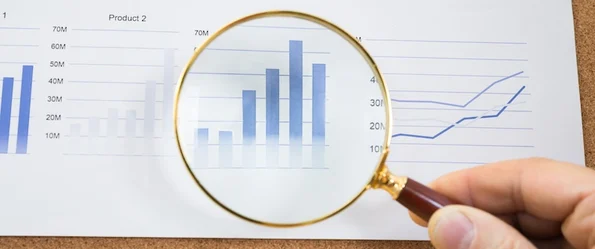This summer -- as countries reopened -- people who'd been stuck inside were finally breathing a cautious sigh of relief. At the same time, some company leaders were doing the opposite.
Why? In past years, entire industries saw summer slumps -- or seasonal dips in sales or web traffic. This year, business leaders expected sharper dips as more consumers finally unplugged. Aside from this, they were also dealing with frequent HR requests from employees who'd been waiting months to take vacations or change companies entirely.
In fact, the Society of Human Resources Management reported that 41% of employees felt burnt out while 48% felt mentally exhausted by the end of their workdays. This, in turn, may have been impacting productivity and job retention levels.
Ultimately, leaders worried that 2021's summer trends would impact their bottom line. But did they?
Throughout the summer, we dove into June and July web traffic and deal data from over 103,000 anonymous HubSpot customers around the globe. Then, we compared their summer results to pre-pandemic benchmarks from the summer of 2019. These were our key findings:
2021 Summer Business Performance
Note: When looking at the charts and data below, each year's traffic or deal benchmark is equal to its April numbers. Therefore, if industries were 10% under benchmark in June 2019, they saw a 10% dip since April 2019.
Web Traffic Went Down
In June 2021, global traffic dipped across almost all industries and segments. Compared to 2019, websites also saw less overall traffic growth. This dipping continued throughout the summer, while 2019 saw traffic slump level out by that point in the season.
Trouble seeing this graph? Click here for a JPEG..
The only industry that wasn't slumping traffic-wise was Leisure and Hospitality, which saw a whopping 17.72% traffic increase between April and June of 2021. This was nearly the opposite of what we saw in 2019 when traffic decreased for websites in the industry by 13.27% from April to June.
Although Leisure and Hospitality's early and continued summer traffic patterns were impressive, they're still fairly unsurprising as news outlets continued to report spikes in reopening-related travel, outings, and excursions this summer.
Trouble seeing this graph? Click here for a PDF.
A few of the industries that saw the largest initial dips in traffic from April to June 2021 are Construction (-12%), Financial Activities (-11%), Manufacturing (-7.2%), and Trade, Transportation, and Utilities (-7.1%)
When looking at our data, June seemed to be the month with the most seasonal changes or slumps. As compared to 2019, some of the segments that saw larger traffic slumps were Trade, Transportation, and Utilities -- which saw 3.7% growth from April to June in 2019 and a 7.11% loss during the same time in 2021; Education and Health Services -- which saw 17.52% growth in 2019, but a 2.7% loss in 2021; and Construction -- which only saw a 0.16% decrease by June of 2019 but saw a 12.06% loss in 2021.

Aside from Leisure and Hospitality, segments seeing the smallest slumps in summer traffic were Professional and Business Services with under a 1% drop, and Education and Health Services with just a 2.7% drop.
From a geographic standpoint, these traffic trends happened in all territories, except for Asia (and Australia later in the summer). These geographies either saw steady growth or leveled out traffic rather than large dips.
Trouble seeing this graph? Click here for a PDF.
While it's unclear why Asia's web traffic rose and Australia's traffic stopped dipping, these trends might have been due to lockdowns and stay-at-home orders in these territories due to the continuing pandemic.
Deals Went Up
Yes. You read that correctly. While traffic is seeing a summer slowdown, deal closings across industries are climbing.
Industries seeing the biggest growth from April to June of 2021 include Leisure and Hospitality (+44.7%), Manufacturing (+13.65%), and Trade, Transportation, and Utilities (+10.62%), while segments seeing the slowest growth are Construction and Financial Activities, which both have just under a 2% increase from their April benchmarks.
Businesses are also seeing a higher rate of deal closings than they did between April and June of 2019 -- when five of the eight segments we studied saw at least a 3.5% dip in deal closings.
Trouble seeing this graph? Click here for a PDF.
While deal closings were up in June, and only dipped slightly in the later summer months, leaders still aimed to remain cautious throughout the summer.
Although deals were climbing, it was thought that businesses could've still seen dips in later summer months due to consumers continuing to travel, employee vacations, or teams feeling less pressured to close deals at the beginning of a new quarter. However, one optimistic point to note was that deal closings did not see similar lifts in June 2019, when many industries actually saw dips.
Ultimately, during summer or other seasonal slumps, successful leaders monitored traffic, as well as deals created, qualified leads, and deals closed to get a full look at their brand's performance.
This data shows that more deal closings, but fewer qualified leads, signups, or deals created during seasonal slumps might not be a cause for concern. However, when your business sees a slowdown or shift of any kind, there are plenty of steps you can take to ensure future success.
How to Prepare For and Respond to Seasonal Trends
Although summer has come to an end, seasonality will always be something brands need to navigate. Whether you're in a summer or winter slump, or seeing a seasonal uptick in business -- here are some expert tips on how to keep your business growing and thriving year round.
1. Prepare when you can for business shifts.
During a seasonal slump, businesses can still take time to predict and prepare for what's to come.
Alicia Butler Pierre, Host of the Business Infrastructure Podcast and CEO of Equilibria, Inc. says, "There are two major ways businesses can predict, diagnose, and/or prepare for a seasonal slump: resource planning and contingency planning."
- Contingency planning: This strategy -- which often includes creating a premortem, failure modes and effects analysis (FMEA), and disaster recovery and business continuity plan --helps brands prepare for unexpected dips or upticks caused by outside factors like news events or national disasters.
- Resource planning: "As your company utilizes different resources that serve as inputs into producing a good or delivering a service (outputs), you should collect data such as transaction dates, sale or invoice amounts, product or service type, and some customer demographic data." says Butler Pierre. "If you notice the same patterns and trends year after year, you are in a better position to forecast and prepare for seasonal slumps. This, in turn, lets you know when to expand or contract inputs like labor and inventory."

Image Courtesy of Alicia Butler Pierre
Data shows that a strong plan can be rewarding when business begins to pick up. In 2020, as consumers quickly turned to online stores for essentials, businesses that weren't online were rushing to build online stores, while online stores were struggling to fulfill high-demand orders on time. Many shoppers chose to buy products from brands with more product availability over brands they were originally loyal to.
"I strongly advocate businesses focus on improvements to their business infrastructure during seasonal slumps. It’s difficult to make improvements while things are moving so quickly, as all hands are on deck trying to fulfill orders and meet project deadlines," says Butler Pierre.

"Improvements can include things like technology and equipment upgrades, process automation, and reconfiguring (or relocating) your physical work location. With these improvements in place, your company can work through the chaos that can accompany a seasonal uptick without compromising quality and excellent customer service," Butler Pierre adds.
2. Launch demand plays.
"Unfortunately, when you're dealing with macro trends in the market a lot is out of your control," says Emmy Jonassen, HubSpot's VP of Acquisition. "For example, there's not much you can do if prospects are not visiting your site or talking to reps because they're all on vacation."
While you might not be able to solve seasonal business patterns, Jonassen says there are things you can do in the now to help the short and long term:
- Getting through the slump: When you're facing a period of slowed demand, any incremental lift at the top of the funnel can go a long way. During times like these consider adjustments you could make in the short term to help in the short term. For example, could you increase your paid spend temporarily? Could you remove a field in your lead form for a period of time to improve CVR? Could you manufacture a bit of demand with a campaign or offer that provides timely and unique value?
- Making the most of what you have: In periods of soft demand, you want to make sure that you're not leaving anything on the table. One way to do this is to perform an audit of your key acquisition drivers and invest in making optimizations. For example, if you're able to improve search rankings and conversion rates of core landing pages, it will help you generate incremental demand. Investing in these kinds of optimizations will also put you in a much better position to capture demand when traffic does start to pick up.
- Weatherproof for the long-term: Periods of slowed demand can help us see where the holes are in our demand-generation engines. Use this time to identify where your engine's holes are and put in place plans that work toward patching them in the future. For example, if your desktop conversion rates are outperforming your mobile conversion rates because you haven't invested in a mobile-optimized site, now could be a great time to start planning that project.
3. Use data to guide your strategy.
Although dips on website views might concern you, seasonal traffic slumps aren't unusual. And, you can use analytics tools to prepare for and respond to them.
On the HubSpot Blog team, we use tools like HubSpot Traffic Analytics to examine and prepare for seasonal dips due to vacations, office closings, and global holidays that take people off-line during the summer or winter months.
Because summer and winter are filled with vacations and holidays, we often use summer to focus on historical optimization, long-term conversion plays, process planning, and trend-responsive content that can gain quick bursts in traffic when search engines are impacted by seasonality. Meanwhile, we'll often perform end-of-year planning and take personal time to recharge in winter, so we can start a new year fully refueled.
While a seasonal slump is a good time to look at and respond to unexpected traffic losses, it's also important to remember that some decreases could be beyond your control and mostly due to seasonality. Additionally, if you're a leader, you should look at other data aside from just traffic.
For example, you might also want to take a wider look at KPIs like online leads, email subscriber growth, online sales, and deal creation to learn how much web traffic losses are immediately impacting you. If traffic is down, but leads or deals are up, you might not need to pivot your whole strategy. If everything is going down -- that's when you might want to take a deep look at your overall processes.
Ultimately, as with process planning, digging into the analytics you have available will help you determine the best way to handle a traffic slump or uptick. To learn more about building an effective web analytics strategy specifically, check out this post.
4. Don't forget about your current customers.
While deals are on the rise at the moment, some industries, such as construction and financial activities historically see dips or slower growth in the summer. Luckily, when business is slow, you can still take the time you need to maintain and potentially gain more business from your current clientele.
From a sales leadership perspective, Dan Tyre, Director at HubSpot, says that managers and teams should "look for ways to upsell or cross-sell new customers from the first six months of the year" or "use the time to work your referral program."
"I like to call top customers in July to check in regarding the state of our relationship and see if there are other divisions or connections that can use similar help," Tyre adds.
Additionally, leaders and companies can take more time to ensure their processes and operations are running smoothly when business is slow.
Regardless of whether you're focused on gaining new clients or maintaining your customer list, tools like HubSpot's Sales or Service Hubs can help you by allowing you to track deal creation, contact activities, and service inquiries. You can also use these tools to communicate with customers and prospects across different platforms like email, WhatsApp, and Facebook Messenger.
5. Strengthen team communication.
While you'll want to stay in contact with prospects and customers during times of slump or business uptick, communication with your team will also be incredibly vital. While poor communication can halt processes completely, great communication could speed up the pace of projects that provide great revenue.
Regardless of how busy your business is, take time to check in with your teams through meetings, platforms like Slack or Zoom, or email updates.
Additionally, to keep everyone in the know of each other's schedules during a busy summer, you should ensure that calendars are up to date with meeting times, blocks for heads-down solo work, and time off.
6. Balance results with employee well-being.
As seasonal trends fluctuate, it can be easy for managers and teams to get swept up with work and forget about taking time to unplug. And, as economies reopen and employees gain the ability to travel, the balance between self-care and productivity will be even more important for leaders to consider.
"Time away from the office may be a bit more pronounced this year, but it's not unique. The key to any process is managing expectations and understanding who's available when to keep consistency in the sales process," Tyre explains. "It's advantageous for everyone to manage lower levels of stress and take time off. In many cases, a no-meeting Friday or work from home Friday can increase salespeople productivity."
Senior Product Marketing Manager Alex Girard similarly says, "First, I think it’s important to understand the value in taking time off. When employees use their time off, they’ll come back refreshed and able to do their best work."
"Second, make sure you’re prioritizing the important work that will drive real impact," Girard adds. "If your team is taking time off, make sure everyone on the team is aligned around what’s important, what is not, and what can be postponed for later. This will ensure you keep things moving during periods of high vacation time."
Tools to Help You Navigate a Seasonal Slump or Uptick
- HubSpot Business Software: HubSpot's CRM, Marketing, Sales, Service, and Content Hub can help you and your team measure your performance; identify slumps, upticks, or major snags in your process; and assist you in moving customers through the buyer's journey -- even during a time of seasonality.
- Google Workspace or Microsoft Outlook: These programs allow teams to keep all their documents, calendars, and emails in one suite of tools that can streamline communication, project management, and the creation of new processes that will be vital to business growth.
- Task Management Tools: If you work with multiple teammates or are managing multiple projects this summer, tools like HubSpot, Trello, Asana, and Jira can help you track the progress of what your team is working on and identify where any blockers might exist.
- Communication Tools: Lastly, if you're on a dispersed team like many HubSpotters, you'll want to leverage a communication platform like Slack, Microsoft Teams, or Zoom to stay in contact with everyone you're working with -- even when there's not enough time to schedule a meeting or check-in.
Editor's Notes:
1. This post was first published in July 2021, but was updated in September to follow up data from the later summer months.
2, The data from HubSpot’s customer base is reflective of companies that have invested in an online presence and use inbound as a key part of their growth strategy. Because the data is aggregated, please keep in mind that individual businesses, including HubSpot’s, may differ based on their own markets, customer base, industry, geography, stage, and/or other factors.
How We Protect the Privacy of Our Customers’ Data
We employ the following anonymization techniques to remove or modify personally identifiable information so that data cannot be associated with any one individual:
- Attribute suppression refers to the removal of an entire part of data in a dataset. Before sharing any customer data we apply suppression to any data attribute that on its own identifies an individual (e.g. name, company name) or has been assigned to an individual.
- Generalization involves a deliberate reduction in the precision of data, such as converting company size into a company size range. We apply generalization to indirect identifiers. These are data attributes that on their own don't identify individuals, but could identify an individual when combined with other information. We use the k-anonymity model as a guideline to ensure any record’s direct and/or indirect identifiers are shared by at least k(set at 100)-1 other records, protecting our customer’s data against linking attacks.
- Aggregation refers to converting a dataset from a list of records to summarized values. We apply aggregation by displaying a cohort’s mean or median values for a metric.
Marketing Analytics


![Download Now: Free State of Marketing Report [Updated for 2025]](https://no-cache.hubspot.com/cta/default/53/b0f73a5e-16e4-41fd-9511-8564efc560a7.png)


![A Simple Guide to Marketing ROI [Formula & Examples]](https://53.fs1.hubspotusercontent-na1.net/hubfs/53/a-simple-guide-to-marketing-ROI.webp)




![Improve Conversion Rates by Changing Your Shipping Options [Infographic]](https://53.fs1.hubspotusercontent-na1.net/hub/53/file-2633582302-jpg/eCommerce/121.jpg)

